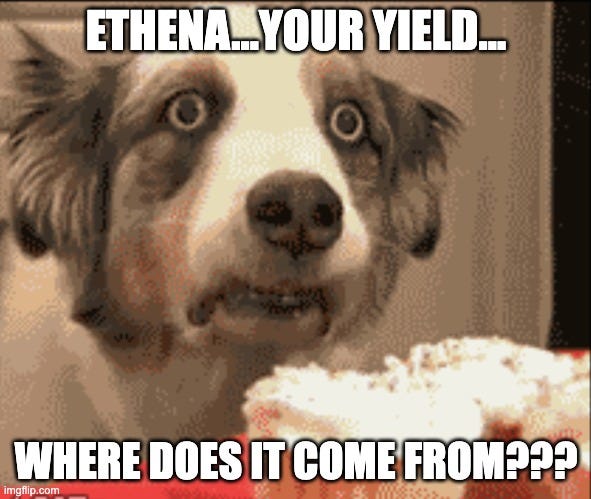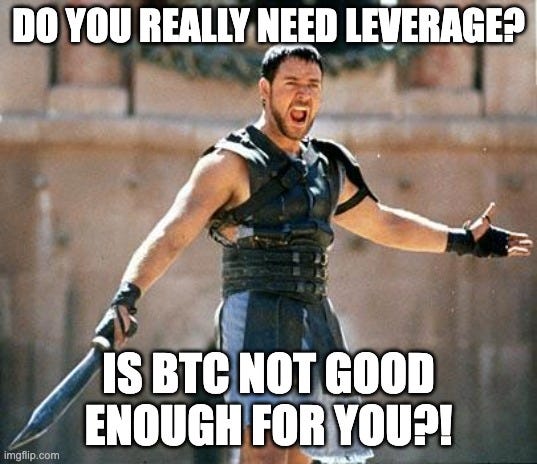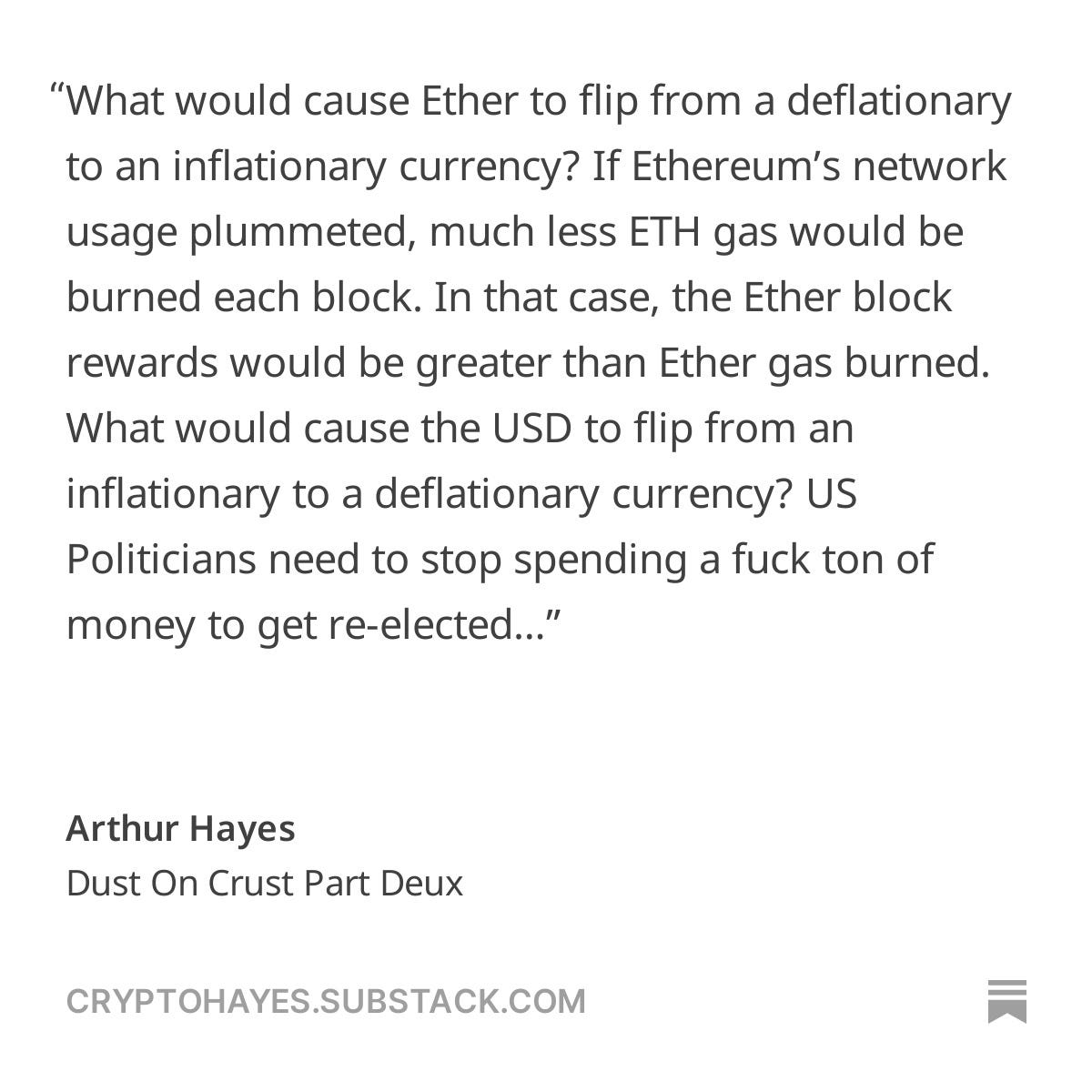Alright, let’s talk about Ethena and USDe. First, deep breath.
If you want to trigger an entire community’s PTSD , just tell them you’ve come up with a new yield-bearing stable coin…
For reference, all of the links in this article are referral links. I’m not trying to pull a fast one on you and I usually like to give people multiple links so they can support me or not. But Ethena requires a referral code…so here we are, both caught in the web of crypto’s hair-brained airdrop farming schemes. You do get a 10% farming boost if you use my referral link…
The Index
Welcome to Ethena
If we’re judging Ethena based off of how clutch their keywords are, give them the crown. The Internet bond…The synthetic dollar…
I mean, come on, maybe it’s just the writer in me, but wake up people of DeFi! It matters what your product is called! Learn. From. Ethena.
In a sentence, Ethena is the new product on the block, offering a stable coin, collateralized with ETH, pegged to the dollar, using perpetual shorts for stability, with a built-in yield derived from ETH’s staking yield and some money made by holding those shorts (more explanation on that below).
I know, that’s a lot. I want to break this down as simply as possible because this protocol has come across my desk several times recently. Ok, maybe not my desk, but my notification feed! Ugh…2024 is so less romantic. I want to be typewriting this article in a little office laden with cigarette smoke…
Why Am I Writing This?
The main reason I’m writing this is for the same reason I write anything – someone asked me to and I wanted to do so for my own research purposes.
There are a few main questions I want to hit with this article, questions I find myself asking myself – which, admittedly, is a very strange person for me to ask, since clearly, neither of us currently has the answer. That is why we are writing this article, I mean me…I…that’s why I’m writing this article:
An understanding of Ethena that my grandma could get behind
A thorough understanding of how Ethena generates its yield
An assessment of the risks
Ethena Protocol TL;DR:
If you want don’t want to read anymore, you can read this snippet to get my opinion of the protocol:
Overall, it’s very interesting. The economics of the protocol seem sound and I think it will be a valuable product. This is not another LUNA/UST ponzi! However, there is certainty risk here.
However, you should be aware of what it is. It is not promising to be the stable coin with the tightest peg (and even the team isn’t saying that). They aren’t guaranteeing that this will always be 1:1 exactly with the dollar. They also aren’t guaranteeing that it will always have an attractive yield.
So what is it? This is a synthetic dollar which is much more independent from TradFi than something like Tether, that can provide predictably higher returns than simple staked ETH, that has a doxxed, experienced team, and will likely play the long regulatory game.
I think that USDe becomes a mainstay in DeFi and I would consider getting in on their future airdrop, or acquiring some governance tokens to the platform once it launches.
Ethena Protocol – ELI5 (Explain Like I’m Five)
Ethena has created a stable coin with 60ish% APR at the time of writing. It’s called *drumroll please* – USDe. Reeeeaaaaal original guys… (apparently, ‘e’ was the last letter available after ‘t, g, c, p’ are all taken!)
Approved parties can mint and redeem USDe from various exchanges by depositing stETH onto the platform. If ever prices differ between exchanges, arbiters will take advantage.
All USDe tokens are backed 1:1 by stETH.
Now you, saavy crypto reader, might now ask…”wen moon???”
NO! Wrong place, wrong time. You were supposed to ask, “how does Ethena maintain stability with only a 1:1 collateralization ratio with an asset as volatile as stETH?!?”
They do this by opening: “a corresponding short perpetual position for the approximate same dollar value on a derivatives exchange.”
What they’re saying here is that, when someone mints $1 of USDe, Ethena goes and opens up a short position on an exchange. They use the stETH deposit as collateral. (We’ll explain this more below).
*Eyes flip nervously back and forth between Ethena’s website and the Luna/Terra wikipedia article*….WHERE does the yield come from?
You’re finally paying attention. Or you’ve got a case of crypto PTSD but, haha…who doesn’t…am I right? Am I right? *nervous laughter turns to tears*
The ETH comes from the native yield generated by staked ETH + the funding and basis spread from the delta hedging derivatives positions.
Ok, well, to understand this, we need to understand what a crypto funding rate is and to do that, we have to start with: What Are Options:
How Does Ethena Protocol Work? TL;DR:
Very simply, Ethena holds stETH and issues USDe 1:1, with that stETH as collateral. They also hold short positions on ETH which means that they make money when ETH goes down. This protects the collateral. They also earn a funding rate on their short position which is their reward for holding options that are shorting the market when the general market is going long. They pass along that yield from the funding rate and the native yield from the stETH to USDe holders in the form of yiiiiieeeeeelllllddd.
Crypto Perps & Options – ELI5
Options and futures/shorts are pretty similar. Both are agreements to buy or sell an asset at an agreed upon price in the future. With futures, you HAVE to sell the asset on that date, at the price. With an option, you have the option to do so. If you want, you can let the contract expire (you, of course, would lose the amount that you paid for that contract).
Now, crypto doesn’t like constraints, so they use something called perpetual futures (aka perpetual swaps aka perpetuals aka Perps – fml, no wonder this shit seems complicated). Perp contracts are contracts that never expire.
Now, you might ask, what’s the difference between a Perp and the underlying asset? I had to ask myself this too since, in essence, if you have a contract to buy something but you never have to buy it and there’s no expiration date, essentially, you’re just holding the underlying asset, right?
This is kind of true. The difference is that Perps are much more efficient and flexible and thus, they’re the preferred asset of crypto exchanges. So…if you want to trade on margin (in other words, with leverage), you must use Perps.
On a side note, when people say they’re going long or going short, this can mean many different things. The easiest way to “long” or “short” an asset is simply by buying or selling that asset. But usually they don’t mean that. What they probably mean is that they’re using leverage which basically means that they’re borrowing that asset. If they’re shorting the asset, they’re going to borrow it and then sell it. If they’re longing the asset, they’re just going to borrow it and hold on to it.
So Perps aren’t really that special, other than that if you want to be able to use the full spectrum of financial tools, those markets will be built on Perps.
Perps TL;DR:
Very simply, perps are basically just much more efficient representations of underlying assets that are preferred by exchanges for leveraged trading (i.e. going long or short).
What Is A Funding Rate? – ELI5
However, there can be times when there is a slight difference between the price of the perp and the price of the underlying asset.
Why? Mostly because there is a desire to go long with leverage, so degens are lining up to buy the Perp more than they’re lining up to buy the actual asset. F**king crazy degenerates.
So as the market goes up and people want to leverage long (i.e. borrow a lot of the asset), there’s more demand for Perps and the price of a Perp tends to be higher than the price of the actual asset.
This is called a Basis.
The basis is the difference in price between the Perp and the underlying asset. Too high of a basis is really problematic since the whole derivative market is built on assumption that these derivatives are closely linked to the underlying asset.
So…what do they do?
Well, they penalize perp holders. This is called a Funding Rate.
The funding rate can be positive or negative depending on if there is more or less demand for the perp than the underlying asset.
When would there be more demand for the Perp? When the market is optimistic and people want to go long so there’s more demand to buy the Perp.
When would there be less demand for the Perp? When the market is pessimistic and people want to go short, meaning they’re borrowing the Perp and selling it, creating downward pressure.
So…
Positive Funding Rate = Bull Market
Negative Funding Rate = Bear Market
When there is a positive funding rate, those who have long positions (i.e. hold the Perp) have to pay those who have short positions and vice versa. This basically rewards people trading against the majority and penalizes those with the majority. At the time of writing this article, the BTC funding rate is about .015%. This percentage is generally paid EVERY eight hours.
So…if you wanted to purchase $100,000 in BTC longs, the cost of those longs would be $15 every eight hours. That adds up. That also means that, if you wanted to earn some yield, you could hold BTC shorts and earn that amount.
That leads us back to Ethena:
Where Does Ethena’s Yield Come From?
Since Ethena’s synthetic dollar – USDe – is backed by stETH, the yield, as we said before, is a combination of:
the native yield from ETH (approx. 4%)
+
the funding rate for ETH shorts
Right now, that equates to about 60% annual yield.
This yield will obviously fluctuate based off the funding rate which is based off market sentiment.
Is this yield sustainable?
Listen to Vitalik speak about this:
“Anything that offers more than a 10% APR is unsustainable at best, and a scam at worst.”
OMG didn’t Vitalik just say this is a scam?!?! It’s Luna all over again!! Call the SEC! Call Batman….fuck, who do we even call?
Hold your horses.
What he actually said that it’s unsustainable which I would agree with and I think even the Ethena team would agree with.
They are not promising 60% returns. They are saying that they have developed a product which, according to the brief time it’s been around (and historical estimates), is able to maintain stability and pass along a higher yield than the simple ETH yield, all without taking on too much risk (too much is relative obviously).
The 60% yield is a reflection of the current funding rate set by the market. This yield will change along with the market. Flexible yields set by market forces are the definition of sustainable because, well, there’s nothing to sustain! Unsustainable yield are those that are guaranteed at a certain percentage…always…like UST. Unless you’re a POS protocol or the federal government, that doesn’t work (and it doesn’t even really work for the Fed!)
How Does USDe Stay Stable – ELI5?
In other words, Ethena maintains a stable price of USDe, because…if ETH goes down, Ethena makes money with their shorts and this offsets the loss in the value of the collateralized stETH. This, combined with the payouts from the funding rate, is enough to pass along yield to holders of USDe.
If ETH goes up, Ethena loses on their short positions, but the value of the collateral (stETH) goes up and evens itself out.
The Risk With Ethena (IMO)
There’s obviously risk here in terms of protocol risk and the risk of insolvency when it comes to centralized exchanges holding their short positions. This is important to consider, especially when we have fully decentralized stable coins like f(x)USD. However, Ethena is mitigating this risk by not posting their collateral directly with the exchanges, but rather, by using a trusted custodian who delegates the collateral to various exchanges – a more efficient process and a safer one (assuming the custodian is a good one).
However, the biggest risk here comes in the form of a sustained negative funding rate on ETH. Since Ethena needs to hedge with short positions on ETH to maintain a stable USDe price, if there was a prolonged period of negative funding rates, Ethena would begin to bleed money. They do have an insurance fund right now which captures 5% of the funding rate income. This fund is currently at about $15 million.
In the case of prolonged negative funding rates, Ethena would burn through this insurance money and, eventually, would either have to attach that negative funding rate to USDe (essentially, taking collateral away from holders of USDe), or they would collapse.
Realistically, the team has published historical analysis and showed that, with the additional yield provided by stETH, only about 10% of total days had a negative funding rate, which, is totally coverable by the current insurance fund. This accounts even for the massive crashes in 2021.
Also,
, the inspiration behind the Ethena idea, has said that, long term, USD is an inflationary asset while ETH should be a deflationary asset, which should mean funding rates remain positive.He said it well. Everything seems to point to these two trends continuing.
Essentially, a bet on Ethena is a bet on a positive funding rate which is a bet on ETH outperforming the USD in the long run.
The other risk I want to discuss is the difficulty in maintaining derivative positions across multiple exchanges and managing those positions in real-time. What if there was a massive price movement? I know some of these positions are managed by automated systems, but…in a black swan event…what if Ethena could not exit their positions fast enough and got liquidated?
This is a possibility. However, I do want to say that, according to estimates in official Ethena documents, even in the 2021 crash, this would not have happened.
All in all, I’m comfortable with this risk. I don’t think USDe is being oversold. I think this is a novel idea with a unique approach, with recognized and stated risk. Do your own research and understand the product you are purchasing. This is a novel and innovative protocol and who the f knows what will happen. However, the team is humble and honest and the economics appear sound.
Ethena in a Black Swan Event
Imagine if crypto tanked very very badly and the funding rate inverted to the point where USDe was actually running a negative interest rate. Let’s say that this event caused Ethena to use up almost all of their insurance fund. First off, Ethena would likely have made a lot of money through their shorts in the market crash. At this point, Ethena would need to either sell off their stETH collateral positions to pay the funding rate, or they would have to close their short positions. No one would continue to hold USDe in either case and there would be a rush to exit those positions in Liquidity Pools across DeFi. This is probably where there would be the highest chance of USDe depegging.
This is something that we have to be wary about.
Ethena Risk TL;DR:
Other than protocol risk and exchange insolvency, the main risk with Ethena is that there is a prolonged period of negative funding rates which would make it too expensive for them to hold their short positions and ultimately, reduce their USDe stable coin back into volatile ETH. This would be unprecedented as, even with all the historical volatility, Ethena’s economics should have worked. But, it COULD spell disaster for Ethena if that was the case.
There is also the potential where Ethena mismanages their short positions and loses their collateral (your and my collateral). However, they are transparent with their holdings and it’s up to you whether you think they’re professional enough to NOT DO THIS.
The Difference Between UST and USDe
If the difference is not clear to you yet, let me explain it to you:
The key differences we need to explore are:
How they both maintain(ed) stability?
From whence comes their yield?
Stability Mechanism:
UST maintained stability without any collateralization, by guaranteeing that people could always exchange $1 worth of UST for $1 worth of LUNA. They speculated that LUNA would always have value because they were building LUNA to be valuable!!
USDe maintains stability with 100% collateralization with stETH and then uses short positions to hedge against ETH volatility, passing back the profits from the short positions to account for any loss in the value of the stETH collateral.
Very simply put, one is not like the other. One was backed by nothing, while one has 100% collateral. One has a logical system in place with the use of established financial instruments to maintain its price while the other had no system in place other than…“arbitrage will save the day!”
Yield Generation:
UST promised 20% return on UST deposits and generated that yield by loaning out the UST to other borrowers for more than 20%. UST guaranteed their yield.
USDe generates its yield by combining the native yield from ETH + the money earned from the funding rate on ETH perps (which will be in Ethena’s favor as long as the market is generally bullish on ETH). USDe makes no guarantee about the yield and says that it surely will fluctuate, perhaps a lot.
The Bottom Line
I went into this project pretty blindly because people asked for this article, without any established opinion.
Overall, I think this is a very interesting protocol and I respect what they’re doing.
I think the key thing is not to think of this as a stable coin, but as a synthetic dollar. A synthetic dollar’s value will fluctuate a little bit and has its own yield associated with the asset. I think that someone who is interested in maintaining total stability of their assets should use USDC or USDT (although, they’re also not without risks). Someone who wants their stable coin pegged to ETH, with ETH native yield, should use fETH. Someone who wants a totally decentralized, DAO-backed, approach to their stable coin should use f(x)USD.
But someone who is interested in holding what I think will be a very stable asset with a yield that is reliably sourced (and higher than ETH’s native yield), backed by a VC-rich team, should hold USDe. I could see this becoming one of the preferred on-chain stable asset, providing transparency and sound economics in a way that other stables can’t and providing the accountability and regulatory certainty that more decentralized stables cannot. However, there is risk here in the event of a sustained market downturn. My hope is that - in that case – Ethena would close their short positions and give everyone the option to redeem USDe for their stETH.
All in all, I think this product is what it is. I don’t think it’s promising more than it can deliver. I don’t think it’s risk free. But I think that, provided you understand how this works, get in there.
Airdrop Farming Recommendation
If you want to be a guinea pig and airdrop farming degen, if you purchase USDe and stake it with Ethena right now (until April 1), you can farm their airdrop. I don’t love this whole airdrop farming thing, but I am a sucker for free(ish) money, especially with protocols that aren’t scams. You can’t mint USDe right now, but you can swap for it and stake it.
If you are bullish on crypto and don’t have a bunch of cash lying around but still want to obtain USDe to farm the airdrop. What I did is:
Deposit ETH on AAVE
Borrow a stable coin – crvUSD was the one I used since it had the lowest rate and can be used to Ethena to swap for USDe.
Swap crvUSD for USDe on Ethena.
Do something with your USDe to get points (shards…dance monkey dance!!
This whole thing is rather gas expensive since it’s all done on ETH mainnet. This will probably cost around $60 total with all the token approvals and executions. Consider this before attempting.
I think there is an option to use Injective to farm. I don’t think you can get as many points, but it would be infinitely cheaper.
As always, none of this is financial advice. I am not telling you to buy or sell anything, just sharing my underlying research and conclusions.
I do hold a portfolio of cryptocurrencies. I was not paid by anyone to write this article. I did it on my own with time that earned me zero dollars. I do hold some USDe right now, but only for airdrop farming purposes.
If you would like to support this writing, please, leave me a comment (I love your feedback), pledge on Substack for when/if this newsletter ever goes paid-mode (you won’t be charged, only if/ever we make this paid):
Subscribed
…or you can buy me a cup of coffee or send some ERC20 tokens my way!
ERC-20 Address: 0x4F9960B2A808e8083C2D12420Aba4496D10e6D37









Congrats on an I’m impressive article mate, thanks !
Can you please check this one out and let me know if its legit
Ethenapro.com